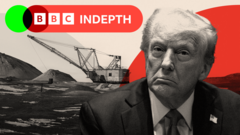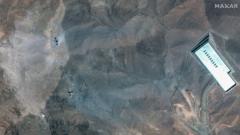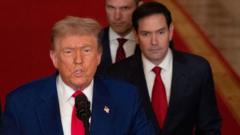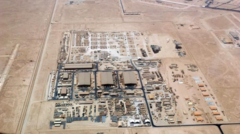Despite his historical opposition to climate initiatives, former President Trump’s recent interest in securing critical minerals from Ukraine, Greenland, and Canada may have unexpected benefits for the US's green technology sector. As demand for such minerals surges, experts warn that the US must catch up to China's dominance in this area.
Trump's Shift in Focus: Could Critical Minerals Drive US Green Technology?

Trump's Shift in Focus: Could Critical Minerals Drive US Green Technology?
As Trump re-engages with the critical minerals market, experts speculate on the potential impact on green technology and the economy.
The unexpected knock-on effect of Trump's minerals ‘deal of the century’
The return of Donald Trump to the White House has sparked discussions about his impact on climate action and technology. Former UN climate chief Christiana Figueres has articulated concerns that Trump's presidency constitutes a significant setback for global climate initiatives. Since his election, Trump has reversed the US's commitment to the Paris Climate Agreement, hampering international collaboration on climate research and dismantling electric vehicle targets, all while dismissing prior administrations’ green technology efforts as a “green new scam.”
Yet Trump's revived interest in securing critical minerals from countries like Ukraine, Greenland, and Canada raises intriguing possibilities. Critical minerals, vital for defense and aerospace industries, are also essential for creating sustainable technologies. Could his focus on these resources inadvertently bolster the US's green technology sector?
Elon Musk, the driving force behind Tesla and SpaceX, highlights the urgency of critical mineral acquisition. Tesla's production hinges on access to lithium for batteries, graphite for electric vehicles, and nickel for rockets. Currently, demand for lithium is surging—estimated to have increased by 30% in 2023 alone—as the clean energy and electric vehicle markets rapidly expand. The International Energy Agency predicts that within two decades, nearly 90% of lithium demand will come from these sectors.
However, a concerning reality confronts the US and its mineral supply chains. A recent report from a US Government Select Committee emphasized the dangers of relying on China for critical minerals and rare earth elements. China's concerted commitment to developing green technologies has led to its current dominance, producing 60% of global rare earths and processing nearly 90% of these crucial materials. Analysts emphasize the economic ramifications if the US fails to assert itself in this arena.
China's early investments in Africa and South America have helped secure its status, but the complexity of mineral extraction and processing hinders other nations’ attempts to catch up. While some minerals, such as lithium, are plentiful, their location can pose logistical challenges for mining. Experts note that disasters or political instability affect supply sources, leading to price fluctuations.
As concerns mount over the US's dependence on China, Trump's mineral strategy appears driven by a desire to reposition the US in the global landscape. The recent discussions suggest potential executive orders focused on critical minerals, potentially facilitating expedited mining efforts within the country. However, experts caution that establishing efficient mineral supply chains requires significant time and expertise, often taking years to materialize.
Although Trump's strategy around critical minerals may support green technologies, analysts assert that the urgency necessitates immediate and comprehensive action. In contrast, the Biden administration's Inflation Reduction Act (IRA) served as a robust stimulus for the green energy sector, generating investments that totaled $493 billion by August 2024. Unfortunately, significant gaps remain in critical mineral procurement processes, emphasizing the need for an upstream focus.
Trump’s recent actions indicate a potential pivot in policy, as he seeks to align critical mineral agreements with domestic progress. However, the political landscape remains fraught with implications for US incumbents facing imminent elections. For many representatives, bolstering the green sector could become a crucial electoral issue.
Despite ongoing uncertainties, confidence persists within the investment community, as experts recognize the necessity of balancing renewable solutions with traditional energy strategies. Ultimately, the complex interplay between Trump's critical mineral initiatives and green technology evolution remains to be seen, as the US continues to navigate its position on the international climate stage.
This scenario unfolds against a backdrop of competing strategic interests, with the potential to reshape the future of energy and technology in the coming years.
The return of Donald Trump to the White House has sparked discussions about his impact on climate action and technology. Former UN climate chief Christiana Figueres has articulated concerns that Trump's presidency constitutes a significant setback for global climate initiatives. Since his election, Trump has reversed the US's commitment to the Paris Climate Agreement, hampering international collaboration on climate research and dismantling electric vehicle targets, all while dismissing prior administrations’ green technology efforts as a “green new scam.”
Yet Trump's revived interest in securing critical minerals from countries like Ukraine, Greenland, and Canada raises intriguing possibilities. Critical minerals, vital for defense and aerospace industries, are also essential for creating sustainable technologies. Could his focus on these resources inadvertently bolster the US's green technology sector?
Elon Musk, the driving force behind Tesla and SpaceX, highlights the urgency of critical mineral acquisition. Tesla's production hinges on access to lithium for batteries, graphite for electric vehicles, and nickel for rockets. Currently, demand for lithium is surging—estimated to have increased by 30% in 2023 alone—as the clean energy and electric vehicle markets rapidly expand. The International Energy Agency predicts that within two decades, nearly 90% of lithium demand will come from these sectors.
However, a concerning reality confronts the US and its mineral supply chains. A recent report from a US Government Select Committee emphasized the dangers of relying on China for critical minerals and rare earth elements. China's concerted commitment to developing green technologies has led to its current dominance, producing 60% of global rare earths and processing nearly 90% of these crucial materials. Analysts emphasize the economic ramifications if the US fails to assert itself in this arena.
China's early investments in Africa and South America have helped secure its status, but the complexity of mineral extraction and processing hinders other nations’ attempts to catch up. While some minerals, such as lithium, are plentiful, their location can pose logistical challenges for mining. Experts note that disasters or political instability affect supply sources, leading to price fluctuations.
As concerns mount over the US's dependence on China, Trump's mineral strategy appears driven by a desire to reposition the US in the global landscape. The recent discussions suggest potential executive orders focused on critical minerals, potentially facilitating expedited mining efforts within the country. However, experts caution that establishing efficient mineral supply chains requires significant time and expertise, often taking years to materialize.
Although Trump's strategy around critical minerals may support green technologies, analysts assert that the urgency necessitates immediate and comprehensive action. In contrast, the Biden administration's Inflation Reduction Act (IRA) served as a robust stimulus for the green energy sector, generating investments that totaled $493 billion by August 2024. Unfortunately, significant gaps remain in critical mineral procurement processes, emphasizing the need for an upstream focus.
Trump’s recent actions indicate a potential pivot in policy, as he seeks to align critical mineral agreements with domestic progress. However, the political landscape remains fraught with implications for US incumbents facing imminent elections. For many representatives, bolstering the green sector could become a crucial electoral issue.
Despite ongoing uncertainties, confidence persists within the investment community, as experts recognize the necessity of balancing renewable solutions with traditional energy strategies. Ultimately, the complex interplay between Trump's critical mineral initiatives and green technology evolution remains to be seen, as the US continues to navigate its position on the international climate stage.
This scenario unfolds against a backdrop of competing strategic interests, with the potential to reshape the future of energy and technology in the coming years.






















